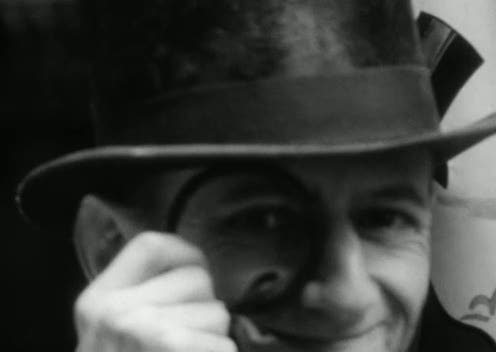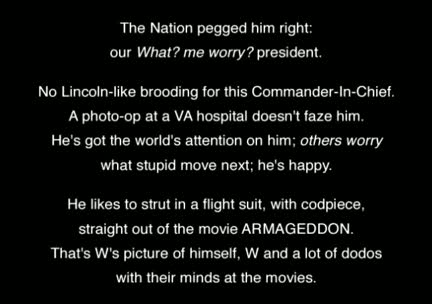“A film adrift in the cosmos… A film found on a dump.” – Week End (1967, JLG)
Whatever one attempts to say about Ken Jacobs’ sprawling, pointed, majestic, self-deprecating, playful, serious, enrapturing, frustrating underground work Star Spangled to Death (1957-2004), apart from becoming contradictory, only turns out reductive, for it is an unwieldy beast of a film. A relentlessly fragmented and remarkably sustained reflection on war, xenophobia, imperialism, religion, ideology, racism, resistance, justice and truth – although always in the American context – Jacobs’ film is simultaneously an anarchist critique of the USA and a celebration of its (possible) glories. Constructed using a dizzying amount of news reels, second rate TV specials, Disney cartoons, excerpts from early Hollywood productions, political speeches and amateur footage, among others, Star Spangled to Death is both a history of America constructed using its mass media and a deconstruction of historiography based on mass media. Rather than trying to write an inevitably insufficient review of this massive film, I chose to embark on a much more mechanical, much more pointless, much more painstaking, much more fascinating and, really, much more rewarding exercise.
For the uninitiated, Jacobs plants hundreds of single frame flash texts – besides equally elusive shards of images and sounds – throughout the seven hour film, each of which lingers for about one twenty-fifth of a second on the screen, into the film. These texts perform the paradoxical function of aggravating the slippery nature of the film and presenting its ideas cut and dried. Of course, this hit-and-run approach is anything but subtle. It’s more like Freudian seepage from the film’s unconscious to its surface. Much like how Jacobs counterpoints narratives of the establishment with the film’s overall structure and trajectory, these texts prove to be the perfect foil to whatever assertions these dominating materials make. There’s another paradox at work here. One one hand, Jacobs’ film – specifically these flash texts – is one that’s uniquely encoded in the film format. These frames – with fixed position in time and space – are much easier to zero in on a reel of film than on an intangible stream of binary numbers. One the other, it’s only a home video that provides one the luxury to navigate the film with ease in order to grab these frames. If cinephilia, in a sense, is defined as an odyssey to capture for life that elusive frame, Star Spangled To Death literalizes the notion and takes it to its extreme.
There is probably no point to this undertaking at all, but I do think it will be useful for viewers like me who actually feel the itch to read all those transitory intertitles without choking the remote buttons. Of course, I must add that I might have missed a number of frames here. Please feel free to point them out to me or, if possible, provide the missing screenshots. (One of the ones here, thanks to the copy of the film I have, is smudged as well. I’d be grateful if anyone could provide a replacement). Without further ado, I present you those notorious twelve and a half seconds of Star Spangled to Death which, I’m guessing, only a few might have seen in its fragmented entirely. Or whatever.
[Readers who are already cursing me (and will be cursing, until this post ages off the main page) for the increased load times, here (6.7Mb) is the collection in a downloadable pdf format]



























































































































































































































































































































February 14, 2011 at 9:06 am
hahahahahahaha JAFB!
I am not cursing you at all, but rather am applauding your attempt to move mountains here. It’s a fascinating work (I’ve never seen it) and it represents the kind of all- inclusive cultural, political and sociological subject that would tempt anyone on their most energetic day. You continue to raise the bar with your unfailingly eclectic thrust.
LikeLike
February 16, 2011 at 12:24 am
Thanks Sam!
You should definitely check it out. It’s a seminal ‘American’ film.
Cheers!
LikeLike
February 14, 2011 at 10:30 am
[…] Just Another Film Buff has again embarked on a monumental project at The Seventh Art, titled “Capturing the Spangles.”: https://theseventhart.info/2011/02/12/capturing-the-spangles/ […]
LikeLike
February 17, 2011 at 2:31 pm
This sounds and looks truly fascinating. The way you describe it (very well, I’m sure) it may be as idiosyncratic and thought-provoking as Godard’s Histoire(s) du Cinema.
Is it readily available?
Thanks. I’d never heard of it.
LikeLike
February 17, 2011 at 11:59 pm
Yes, Stephen. It’s very teasing. And very rewarding as well.
If you are specifically looking for the DVD it’s available at the site: http://www.starspangledtodeath.com/
Cheers!
LikeLike
February 18, 2011 at 12:54 pm
Thanks very much.
LikeLike
February 21, 2011 at 7:33 am
[…] Just Another Film Buff has again embarked on a monumental project at The Seventh Art, titled “Capturing the Spangles.”: https://theseventhart.info/2011/02/12/capturing-the-spangles/ […]
LikeLike
February 21, 2011 at 7:33 am
[…] Just Another Film Buff has again embarked on a monumental project at The Seventh Art, titled “Capturing the Spangles.”: https://theseventhart.info/2011/02/12/capturing-the-spangles/ […]
LikeLike
May 17, 2011 at 12:09 am
[…] The attitude of the film, however, is akin to the opening ethnographic documentary of Ken Jacobs’ Star Spangled to Death (1957-2004), where we are shown and told the story of a glorious white couple teaching science, […]
LikeLike
May 28, 2011 at 5:12 pm
[…] gauges? speedometers?) – is disrupted by disparate single-frame images (a la Ken Jacobs’ Star Spangled To Death (1957-2004)) hurrying past from right to left in a way that also reveals the “filmic” nature of […]
LikeLike